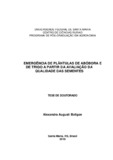| dc.creator | Boligon, Alexandra Augusti | |
| dc.date.accessioned | 2017-04-25 | |
| dc.date.available | 2017-04-25 | |
| dc.date.issued | 2010-01-22 | |
| dc.identifier.citation | BOLIGON, Alexandra Augusti. Squash and wheat seedlings emergency from seeds quality evaluation. 2010. 57 f. Tese (Doutorado em Agronomia) - Universidade Federal de Santa Maria, Santa Maria, 2010. | por |
| dc.identifier.uri | http://repositorio.ufsm.br/handle/1/3188 | |
| dc.description.abstract | The great quantity of vigor tests difficult the determination of the estimators of the seedlings
emergency of each culture. The aim of the study is to identify the wheat and squash seeds analysis variables that best predict the plants emergency of this cultures. The word was carried out of the Crop Science Departament, in the Federal University of Santa Maria. It was
utilized wheat seeds of CEP 30 cultivar and, for the squash seeds of the Caserta, De Tronco, Caravela and Menina Braisleira cultivars.. It was determined for both the cultures, the percentage of normal seedlings in the germination test, first counting of germination,
accelerated aging test, cold test without soil and emergency (at 7th and 15th days of the wheat and 21th days of the squash), root length, total plant length and root dry mass. The germination speed index and the aerial part length were determined for the wheat seeds and the sub optimal temperature test, emergence speed index, hypocotyl dry mass, total dry mass, hypocotyls length e hypocotyls length at the emergency for squash seeds.. The seedlings variables had been analyzed through the path analysis and the tests variable through the stepwise multiple regression, considering the seedlings emergency as
dependent variable. The data had been submitted also to the factors analysis. The percentage of wheat normal seedlings obtained through the accelerated aging test was the adequate variable for to predict the wheat seedlings emergency, in the sub lots of the low and high physiologic quality. For the squash culture, the percentage of normal seedlings obtained in the sub optimal temperature test was the adequate variable for to predict the squash seedlings emergency, of the four cultivars available. | eng |
| dc.description.sponsorship | Conselho Nacional de Desenvolvimento Científico e Tecnológico | |
| dc.format | application/pdf | por |
| dc.language | por | por |
| dc.publisher | Universidade Federal de Santa Maria | por |
| dc.rights | Acesso Aberto | por |
| dc.subject | Testes de vigor | por |
| dc.subject | Qualidade de sementes | por |
| dc.subject | Análise multivariada | por |
| dc.subject | Vigor tests | eng |
| dc.subject | Seeds quality | eng |
| dc.subject | Multivariate analysis | eng |
| dc.title | Emergência de plântulas de abóbora e de trigo a partir da avaliação da qualidade das sementes | por |
| dc.title.alternative | Squash and wheat seedlings emergency from seeds quality evaluation | eng |
| dc.type | Tese | por |
| dc.description.resumo | A grande quantidade de testes de vigor existentes dificulta a utilização destes como estimadores da emergência de pântulas das diferentes culturas. O objetivo do estudo foi
identificar as variáveis da análise de sementes de trigo e de abóbora que melhor predizem a emergência de plântulas dessas culturas. O trabalho foi realizado no Departamento de
Fitotecnia, na Universidade Federal de Santa Maria, utilizando-se sementes de trigo do cultivar CEP 30 e de abóbora dos cultivares Caserta, Caravela, De Tronco e Menina
Brasileira. Foi determinada a percentagem de plântulas normais para ambas as culturas nos testes de germinação, primeira contagem de germinação, envelhecimento acelerado, teste de frio sem solo, emergência (aos sete e 15 dias para o trigo e aos 21 dias para a abóbora), comprimento de raiz, comprimento total de plântula e massa seca de raiz. Também foram determinados o índice de velocidade de germinação e o comprimento de parte aérea para a cultura do trigo e, para a abóbora, o teste de teste de temperatura sub-ótima, além do índice de velocidade de emergência, massa seca de hipocótilo, massa seca total de plântula e comprimento do hipocótilo, no laboratório e na emergência. As variáveis avaliadas nas plântulas foram submetidas à análise de trilha e a percentagem de plântulas normais obtidas nos testes de sementes, à análise de regressão múltipla stepwise, considerando a emergência de plântulas como variável dependente. A análise de fatores foi realizada para
todas as variáveis. A percentagem de plântulas normais obtida no teste de envelhecimento acelerado foi a variável mais adequada para predizer a emergência de plântulas de trigo, em lotes de baixa e de alta qualidade fisiológica. Para a cultura da abóbora, a percentagem de plântulas normais obtida no teste de temperatura subótima foi a variável mais adequada para predizer a emergência de plântulas, nas quatro cultivares avaliadas. | por |
| dc.contributor.advisor1 | Lúcio, Alessandro Dal'Col | |
| dc.contributor.advisor1Lattes | http://lattes.cnpq.br/0972869223145503 | por |
| dc.contributor.referee1 | Garcia, Danton Camacho | |
| dc.contributor.referee1Lattes | http://lattes.cnpq.br/5188663655820823 | por |
| dc.contributor.referee2 | Martin, Thomas Newton | |
| dc.contributor.referee2Lattes | http://lattes.cnpq.br/6293291442552572 | por |
| dc.contributor.referee3 | Jacobi, Luciane Flores | |
| dc.contributor.referee3Lattes | http://lattes.cnpq.br/4372969575747920 | por |
| dc.contributor.referee4 | Lopes, Sidinei José | |
| dc.contributor.referee4Lattes | http://lattes.cnpq.br/7533347017859354 | por |
| dc.creator.Lattes | http://lattes.cnpq.br/7928945879752185 | por |
| dc.publisher.country | BR | por |
| dc.publisher.department | Agronomia | por |
| dc.publisher.initials | UFSM | por |
| dc.publisher.program | Programa de Pós-Graduação em Agronomia | por |
| dc.subject.cnpq | CNPQ::CIENCIAS AGRARIAS::AGRONOMIA | por |


